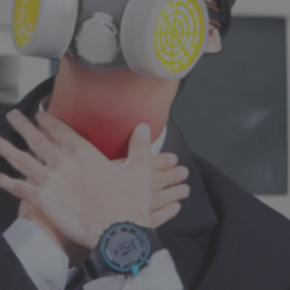
Solving overheating needs to include air quality: Mitsubishi Electric
Hern Yau, Ventilation Product Manager at Mitsubishi Electric, looks at how solving the issue of overheating, especially in summer months, needs to include the matter of air quality.
“Everyone who has worked in or visited a building without air conditioning during a hot summer knows just how uncomfortable an experience it can be.
Hot, sweaty staff and customers struggle with concentration and there can be an increase in drowsiness and headaches.
Productivity can go down while the number of sick days increase, but rectifying the situation may not be as simple as installing air conditioning.
Whilst this will certainly help solve issues with overheating, it is unlikely to deal with the quality of the internal air, unless some form of mechanical ventilation is also included.
With average person spending 80-90% of their time indoors, the quality of the air inside a building has a massive impact on their comfort and wellbeing – far more than the simple measure of temperature.
Missing the point
As an air conditioning manufacturer, we tend to see an increase in sales of smaller units in the summer as businesses that have previously made do without comfort cooling realise they need to find ways to stop their staff and customers overheating.
However, comfort in the workplace goes far beyond indoor temperature during a heat wave so we would always recommend looking at ventilation as well.
Unfortunately, many businesses that rush to install cooling to cope with the heat of the summer are reluctant to spend a little bit more on air quality and will therefore be missing the real point of occupant comfort.
When a building is built today, the proposed building is modelled on computer software taking into consideration solar gains from the orientation of the building and how air tight and insulated the building is.
From this an overheating risk is calculated and to combat any overheating – a ventilation strategy is always the first port of call.
In an older building, the ventilation strategy could have simply of been to have openable windows. However if a cooling system is installed the windows should now be kept closed to avoid wasting energy and money, impacting on the amount of air that can move in and out of the building.
What many businesses will not realise though is that indoor air is often potentially more harmful than the outdoor air and as a result in changing the ventilation strategy, we can quickly see a build-up of chemicals and other pollutants, within the occupied spaces.
Not only can this poor air quality in an office environment reduce the wellbeing of employees, and affect performance, businesses may also be failing in their duty of care as an employer by placing their staff in an environment that could adversely impact their health.
Poor air quality damages health
The news has rightly been full of stories about poor air quality in our towns and cities, but the hidden danger to health of indoor air quality has simply not received as much exposure.
If employees are regularly complaining about headaches, sore, itchy eyes, drowsiness and lack of concentration then this is often a sign of poor quality indoor air.
This will not be solved simply with the addition of air conditioning because, whilst helping regulate indoor temperature to provide comfort to occupants, the air conditioning will do nothing about the build-up of chemicals and pollutants within our buildings.
Indoor pollutants
It’s a well-known attribute of being human that we convert oxygen to carbon dioxide when we breathe and this build-up of CO2 can make internal spaces stuffy and unpleasant to be in. But we aren’t the only pollutant generator found inside buildings.
A not so popularly recognised substance classed as Volatile Organic Compounds (VOC) can cause health effects much worse than CO2.
These VOC’s come from many sources including aerosol sprays, cleaning and disinfectant products, air fresheners, electrical equipment such as printers and photocopiers, and even from perfumes and dry cleaned clothing!
All these things are very common in an office environment, making the need to remove internal air and replace it with fresh air a significant priority if you are trying to provide a comfortable and safe place for staff and customers.
The UK’s Health & Safety Executive found that 30-50% of newly constructed or renovated buildings showed at least some element of sick building syndrome (SBS) – a condition where otherwise healthy individuals experience symptoms of physical distress in the workplace.
Up to 85% of the occupants within these classified ‘sick’ buildings experienced symptoms of SBS.
So how can we ensure that building occupants are provided with enough air at a comfortable temperature to be both productive and healthy, whilst using the least amount of energy possible?
Finding the right solution
This is where MVHR or Mechanical Ventilation with Heat Recovery systems working in tandem with air conditioning can play such an effective role.
MVHR’s are specifically designed to deliver fresh air to a building whilst simultaneously extracting stale air in the most energy efficient way. They do this using advanced heat recovery technology.
As stale air is extracted from a building, up to 80% of the temperature of the outgoing air is recovered and transferred to the incoming fresh air, keeping the building at a comfortable temperature and helping reduce overall energy costs.
If the indoor air is 21°C for example, but the outdoor air is 27°C, then any incoming air needs to be cooled down to 21°C, which means the air conditioning needs to work harder and consume more energy.
With MVHR though, the incoming air into the building will be 22.3°C, by recovering some of temperature drop from the cooler outgoing air. This new air therefore needs less energy to bring it down to the desired temperature, saving energy needed to run the air conditioning.
Furthermore a MVHR equipped with a bypass damper will be able to bring in air direct from outside when the evening approaches and the outside temperature drops, providing cooling for free whenever it can.
This can also be used as a ‘night purge’ where the unit is time clocked under certain conditions to replace all the air inside with cooler night time air to help combat the steady rise in temperature due to passive electrical equipment and give the air conditioning less heat to fight against in the morning.
Include a CO2 sensor to monitor the air quality inside to control the rate of ventilation, ensuring the quantity of air meets the requirements for the number of occupants present and further saving energy.
In the winter the heat may go away but the benefits of MVHR remain. If the indoor air is 21°C and the outdoor air is 2.5°C, by recovering the heat the MVHR will bring in new air at 17°C which again will give the heating system less work to do.
Two types of heat
The best systems are able to deal with both latent heat (moisture and humidity) and sensible heat (temperature) keeping them in balance to deliver a comfortable internal environment that reduces the likelihood of employees suffering from airborne illnesses.
When you consider the fact that 90% of business operating costs are staff related, small changes to the working environment can either help or hinder business growth and success.
Beyond the health implications associated with poor indoor air quality, ranging from respiratory problems, to discomfort and even time off work, it has been estimated that businesses can achieve an 11% increase in productivity thanks to the reduction of airborne pollutants and the delivery of fresh air to workstations.
Couple this with MVHR systems that have a thermal efficiency of 95% and businesses can save an additional 30% on overall running costs, deliver excellent energy efficiency, and provide a healthy environment for your building occupants.
Now that has to be worth looking at, doesn’t it?”
Mitsubishi Electric Living Systems,
Travellers Lane,
Hatfield,
Hertfordshire,
AL10 8XB
United Kingdom
Visit Mitsubishi Electric Living System's website
Visit Supplier's page
Latest news

29th April 2025
Senior pledges to ‘bee’ part of the solution with new biodiversity initiative
Senior Architectural Systems has installed its first on-site beehive, marking another step forward in its commitment to sustainability and biodiversity.
Posted in Articles, Building Industry News, Building Products & Structures, Building Services, Curtain Walling, Doors, Glass, Glazing, Innovations & New Products, news, Restoration & Refurbishment, Retrofit & Renovation, Sustainability & Energy Efficiency, Walls, Windows
29th April 2025
West Fraser range delivering key benefits for South-East carpentry company
An experienced carpenter and building site manager who has recently set up his own company is using high performance panel products from the West Fraser range.
Posted in Articles, Building Industry News, Building Products & Structures, Building Systems, Case Studies, Garden, Restoration & Refurbishment, Retrofit & Renovation, Sustainability & Energy Efficiency, Timber Buildings and Timber Products
29th April 2025
CPD Courses Available Online From Ecological Building Systems
Ecological Building Systems, a leading supplier of natural building products for sustainable construction, has revealed its comprehensive CPD programme for the year ahead.
Posted in Articles, Building Industry Events, Building Industry News, Building Products & Structures, Building Services, Continuing Professional Development (CPD's), Information Technology, Innovations & New Products, Insulation, Restoration & Refurbishment, Retrofit & Renovation, Seminars, Sustainability & Energy Efficiency, Training, Walls, Waste Management & Recycling
29th April 2025
WindowBASE launches new prospect databases at FIT Show
Visit WindowBASE at the FIT Show to see first-hand how it helps companies find new customers – the company is launching an easy-to-use, intuitive platform on Stand G16 at the NEC Birmingham from 29th April – 1st May.
Posted in Articles, Building Industry Events, Building Industry News, Building Products & Structures, Building Services, Doors, Exhibitions and Conferences, Glass, Glazing, Information Technology, Innovations & New Products, Posts, Publications, Research & Materials Testing, Restoration & Refurbishment, Retrofit & Renovation, Windows
 Sign up:
Sign up: